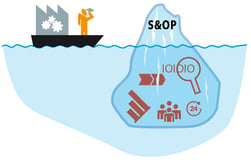How Should Planners Measure S&OE Success?
Jesse Kelber - January 21, 2020

Remember when you were in school? No matter the class, every term you got a syllabus for each class that laid out when exams, quizzes, and term papers were all due? Then you set about working each syllabus into your own personal calendar, with short-term items like quizzes, mid-range ones like exams, and the long-game term papers for each class. There’s a similar way to look at your production planning schedule, with short-, mid-, and long-range goals and KPIs. Long-range is handled by your annual strategic plan, mid-range duties fall to S&OP, and today we’re going to dig into the short-range process of S&OE. Specifically, we’re looking at how to know if your sales & operations execution process is successful or not.
Before we get too deep into this rabbit hole, let’s take a look at a definition for S&OE so we’re all starting out on the same page. Industry leader Gartner defines it as a weekly cycle that tracks and ensures alignment between transport, demand, and inventory, presenting a snapshot of short-term supply chain activity at each monthly S&OP meeting. So, with S&OP handling the monthly or quarterly planning (based on your annual operations plan) for your end-to-end supply chain, S&OE tackles the daily and weekly execution of the plans developed under S&OP. This brings us around full circle to our headline question: how should you, as a production planner, be measuring for S&OE success?
Start With a Summary of Your S&OP KPIs
We’ve gone into depth about these metrics before. To summarize, our top 5 picks for S&OP metrics are as follows:
- On-time delivery: Expressed as a percentage, OTD is a ratio of units delivered on-time to total deliveries made over the same time period. This KPI gives you a great idea of how well you’re hitting your customer service SLAs.
- Production plan adherence: Another percentage, PPA is calculated as (planned production - actual production) / planned production. This number gives you a solid idea of current production output, as well as how your facility will cope with any future spikes in demand.
- Forecast accuracy: Our favorite of the myriad choices for calculating this metric is mean absolute percent error (MAPE), as it gives a succinct picture of your overall supply chain planning success.
- Order cycle time: Whether calculated from PO creation to delivery or order-to-order per client, this metric presents an excellent overview of the health of your end-to-end supply chain.
- Capacity utilization: A simple percentage showing how close to capacity a given plant is, this is often referred to as capacity plan vs actual. Look to this metric when you need a handle on your short-term output planning.
Inventory Tracking Adds to the S&OE Picture
A key, yet often overlooked, aspect of successful short-term planning is how smoothly your warehouse operates. Inventory technology has matured in recent years to a point where tracking data for everything from forklifts to pallets and even individual products is available instantly for analysis. Successful S&OE relies on this real-time data flow to inform the decisions being made about supply orders, how to load the next outgoing truck, and more. Orders are not always produced in sequence, so the ability to store them together despite gaps in production can help speed that order out the door the minute it’s complete. Knowing where each piece of the order is being shelved is crucial to making that happen. By collecting this inventory data over time, you’ll have a much clearer picture of how efficient your warehousing is becoming and where you can focus future efforts to continue cutting wasteful spending.
Use Logistics Data To Fill in Some Blanks
What good is all that inventory tracking if your order is sitting on the loading dock waiting for an overdue truck? The ability to integrate logistics tracking data into your SCMS solution is crucial here. Having the ability to factor in weather conditions, route delays, fuel prices, etc. is what will allow you to avoid that shipment sitting around because it allows trucks to be rerouted on the go or even shift one truck to a different dock right as it arrives. When it comes to optimizing logistics network flows, the power is in real-time data flows. When you know precisely where every truck is at any given moment, your ability to plan not only to the week, but to the minute is greatly enhanced. And it’s that real-time planning ability that will generate the KPIs you can add to your S&OP metrics to gain a fuller understanding of where the waste is and how to go about eliminating it.
Production Numbers Round out Your S&OE Analysis
We didn’t forget about the production stage of the supply chain, we just wanted to be sure it got the attention it deserves. All of this incoming supply order analysis, logistics shuffling, and inventory tracking isn’t worth much if your production numbers can’t keep up. We touched on this briefly up in the section on S&OP metrics you should be watching, but now it’s time for concrete actions you can take to improve those numbers. And that action revolves around IoT sensors. These internet-aware devices provide more real-time data on everything from straightforward numbers of products coming off the line to the health of your equipment. They provide the data your advanced analytics engine uses to calculate everything from demand forecasts to prescriptive maintenance. Since you now have real-time data on production, you’ll be able to monitor those metrics listed above daily and make adjustments as necessary to cut overages and streamline production.
When You Add All That Data Up, You Get S&OE Success
What you’re left with at the end of all this data is a set of metrics you can look to for a snapshot of how your S&OE process is doing. The S&OP metrics give you the data you need on the overall health of your supply chain and production facilities. The logistics section fills you in on the final leg of your product’s journey to the customer. And the production sensors keep you in the know on the operations of your plants. The items in this article are by no means meant to be all-encompassing. We know that each and every company has its own unique situation and the scenarios you encounter as you go about establishing a solid S&OE process to complement your S&OP will vary. Use this piece as a set of guidelines and you’ll be well on your way to that success.
If you want to learn more get your Guide to Sales & Operations Planning
In this Guide you will learn:
-
Why a S&OP Process is important
-
How a S&OP System can be flexible and quickly implemented
-
Central tasks of a S&OP System
-
The key to more productivity
LATEST POSTS
- Understand Circular Economy in The Manufacturing Industry
- How Can Industry 4.0 IT Integration Be Achieved Smoothly?
- The Significance of Order Sequencing in Discrete Manufacturing
- How to improve your Supply Chain Management: The Power of Control Towers
- Optimizing Human Resource Scheduling in Manufacturing: A Technological Approach



